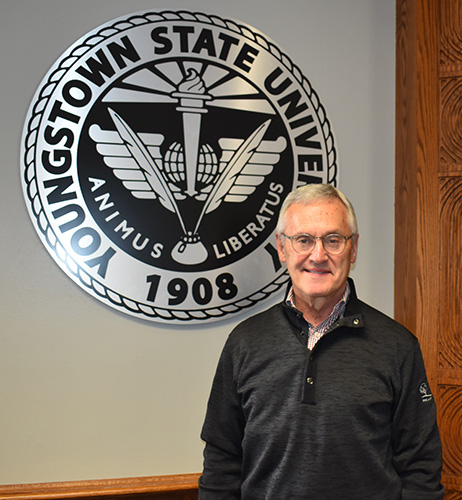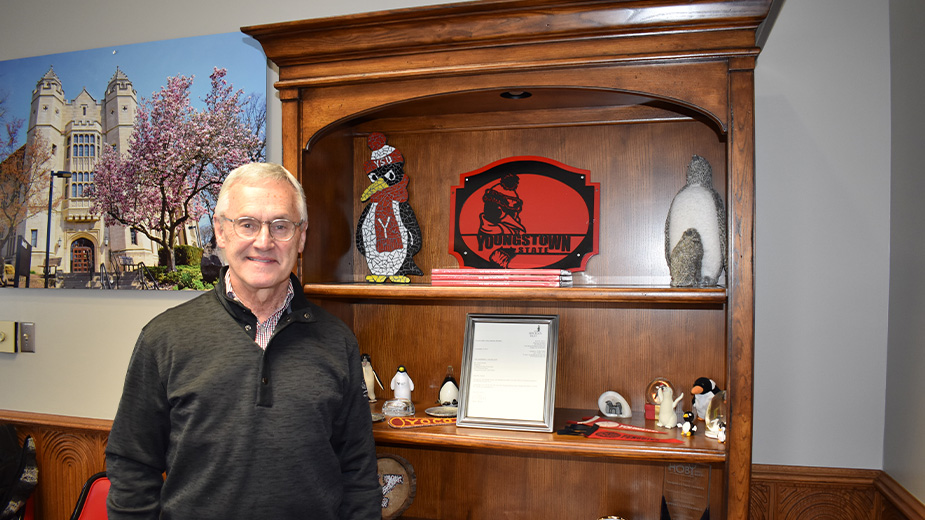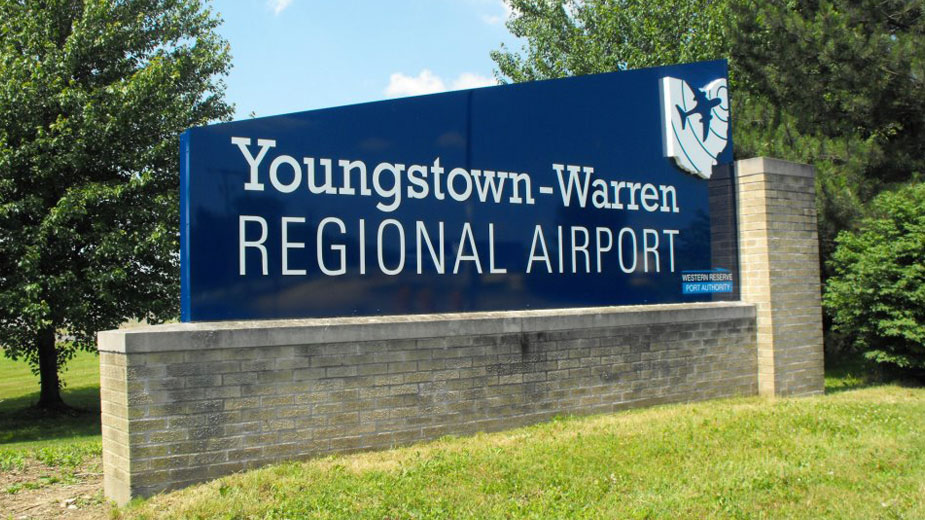Tressel Reflects on Time as YSU President
YOUNGSTOWN, Ohio – As the end nears on Jim Tressel’s tenure as president of Youngstown State University, he recalled what he described as a “daunting moment” during the 2014 visit that he made to campus to meet with people to be considered for the job.
At one point as he drove around the campus area, he parked by the MVR restaurant and thought about Carmine Cassese, the MVR owner and a former YSU equipment manager, who had died a year earlier.
“I thought about how he loved the city and he loved this university, and I thought about all the people and how this place means so much to this region,” he recalled. He considered whether he could “come back in” and “do some good things here.”
Tressel, who came to Youngstown in 1986 as head football coach and would guide the team to four national championships before moving on to Ohio State University, will conclude more than 13 years as YSU’s ninth president Feb. 1.
At the time of his hiring, Tressel was executive vice president of student success at the University of Akron.

“I knew I wanted to do something different than coaching because I’d done that for 38 years and enjoyed every second of it,” he recalled. “But I thought the world was bigger than that.”
While still at Akron, where he also was under consideration for that university’s presidency, the abrupt end of Randy Dunn’s presidency at YSU created an opening – “timing like you never dreamed would happen,” Tressel said.
“It wasn’t like they were looking for someone who clearly had a lot of experience at being president. But they were looking for someone who loved Youngstown State, someone who could bring maybe a little confidence [and] a little stability back to the university and to the region. As fate would have it, I just had two years of going to school on being a higher ed administrator, and this job opened up.”
Tressel’s candidacy was supported early on by business and community leaders – led by then U.S. Rep. Tim Ryan – who signed a letter calling on YSU’s board of trustees to name Tressel as university president following Dunn’s resignation after seven months in the position.
“He was a perfect fit for Youngstown,” said Mike Garvey, president of M-7 Technologies, who signed the letter.
“He’s always excelled in leadership, and we really needed a strong leader after the change that took place down on the campus,” Tom Humphries, former president and CEO of the Youngstown/Warren Regional Chamber, said. “He’s always excelled in leading. He knows how to lead people and manage process, and he’s one of the best at it.”
Listening to Priorities
Tressel said one of his early key initiatives after taking the job was to listen. “That’s so important, when you go somewhere new, is to find out what’s in the hearts and minds of the people that you’re there to serve,” he said.
One of the priorities he heard, especially from students, was the appearance of campus “being in a place that they’re proud of the way it looks and the way it functions,” he said. So he set out to improve streets, housing and other amenities, while working on fundamentals such as attracting faculty and raising money for programs.
The creation of YSU’s Division of Workforce Education and Innovation and the Excellence Training Center was in response to listening to alumni and regional leaders, “tying in what I like to call a stack-and-start approach,” he said. That approach lets engineers get a certificate in robotics, 3-D printing or other certifications to enhance the degree they already possess.
“The other part of it is providing something for [workers] that won’t take four years’ wait to get them into the workforce,” he added. These can include incumbent workers who need retrained to meet new workforce needs, individuals looking for upward mobility or displaced workers.
“The future of numbers for higher education will not be in the 18- to 22-year-old category,” Tressel said. “The real numbers will be in the people that, as the world changes, need to get further training or further credentials.” Online growth has been critical “because when someone’s 28, and maybe has a family and a job, they can’t come here and sit on campus for four years.”
‘Constant Evolution’
Tressel acknowledged there is a “constant evolution in demand” for programs. YSU dropped its two-year nursing program around 2000 because of an overabundance of nurses. But today “we need twice as many nurses as we have,” he said.
Tressel said he is particularly pleased to see closer alignment of the new workforce division and university faculty. Recently, nine faculty members visited the Foxconn complex in Lordstown to see what upcoming needs might be, not only for training but also for research. Products like Apple’s iPhone, which Foxconn manufactures at its other plants, change frequently. So YSU needs to train people to “come up with those ideas that created the change,” he said.
“Every time there’s something new on an iPhone or new in a car, it’s because someone innovated,” he said.
One of the big challenges is attracting faculty who have the freedom to conduct research “when you have limited resources,” leading to several discussions with YSU trustees about what approach the university should take in funding research. One logical area would be vehicle electrification, given the focus of the Foxconn plant, as well as the Ultium Cells plant in Lordstown.
“Research is very costly unless you get research grants,” he said. “Going forward, we’re going to have to figure out who we are in that realm.”
All of the YSU colleges have advisory boards that include members of the local business community who provide input on how the university can serve their needs and how they can better prepare students, Tressel said.
“We need to be out there with the people who are counting on us to give them great talent, and find out what instruction, what experiences, what types of things we need to do to prepare them,” he said.
Chill-Can Project
Tressel’s involvement in the business community also brought him into contact with Mitchell Joseph, CEO of Joseph Company International, who proposed a Chill-Can manufacturing and research complex on the East Side. Mitchell, a YSU graduate, credited Tressel with inspiring him to bring the ill-fated project to Youngstown; his company also entered into an agreement with the YSU athletic department, for which the company still owes YSU nearly $200,000.
YSU’s role in the project was being a “cheerleader,” in the hope that the concept would provide not only jobs but a center of “entrepreneurial excellence” that “didn’t come true,” Tressel said.
“It’s like anything else – when someone comes in with an idea, whether it’s Lordstown Motors or Chill-Can or Ultium batteries or Foxconn or whatever, we’re going to jump on board to see how we can be supportive, and we’re going to cheer for them,” he said. “We’re going to have a positive outlook as to what we hope the results are.”
Relationship with Faculty
Reflecting on his relationship with faculty, which staged a brief strike during the fall 2020 semester, Tressel characterized that as a “natural part of the process,” acknowledging that union leadership and administrators have “certain responsibilities” to fulfill. But he said he enjoys his relationship with every faculty member.
“I tease some of the folks – we don’t always agree on everything, but I promise you I love you,” he said.
“We understand the dynamics of the university,” said Cryshanna Jackson, spokeswoman for the YSU chapter of Ohio Education Association. Many of the difficulties between the faculty and administration are more with the provost’s office, which makes the academic decisions, she said.
Tressel specifically credited the faculty and staff for their performance when the COVID-19 pandemic hit, which left the campus empty for months and forced the shift to an online instruction model.
“That’s where you’ve got to tip your cap to the faculty and staff,” he said. “The faculty turned on a dime.”
Campus Growth
During Tressel’s tenure, the university has experienced growth in its residential population, with thousands of students now living in university dorms and off-campus apartments, a shift that was important because of demographic shifts. Many prospective students would look at YSU but go elsewhere because the university “didn’t seem to have what there was at other places,” he said.
That shift not only helped YSU keep students from going elsewhere but also changed the engagement level on the campus, “because more people were spending more hours here,” he said. One of the big changes was the expansion of the Honors College, which at one time had just 300 students but now has more than 1,200.
YSU also has benefited from growth in international students and the outreach through College Credit Plus, which allows high school students to earn credits. “We’ve tried to go in every direction,” Tressel said.
Fundraising to support expansion of campus facilities and student scholarships saw record growth under Tressel. During the 2021-2022 fiscal year, YSU received a record $24.1 million in gifts and more than $150 million during Tressel’s tenure, the university reported last July. YSU raised $126.2 million through the “We See Tomorrow” capital campaign that ended in September 2021.
Tressel also pointed with pride to graduation rates, which have risen from “the mid-30s” to just under 50%, “really not too bad” for an urban institution, he said.
One area he said he wished he could have done more for – and one he acknowledged was more difficult to quantify than fundraising or graduation rates – was promoting a “culture of community” that emphasized everyone is important. He praised the work being done by Carol Bennett, assistant provost, who has focused on incorporating diversity, equity and inclusion initiatives into the academic setting.
Reflecting on Tressel’s Legacy
“Jim Tressel came to YSU at a time of great challenge,” Tim Ryan said as he reflected on Tressel’s legacy. “The campus looks and feels much different today because of his work. The campus has a deeper connection to the city than it’s ever had.”
Humphries, who said he met with Tressel on a regular basis to discuss how the business community and YSU could partner, said he would give Tressel a grade of A+. “He really built the university back up. People had pride about themselves,” he said.
What Tressel did to the physical presence of the campus, including the apartment developments and upgrades to the campus itself, will be his greatest legacy, said Shannon Tirone, YSU associate vice president and director of university relations. He brought outside money into the Youngstown areas because people “believed in Jim Tressel, and they believed in Youngstown State University,” she said.
Tirone traveled with Tressel and the football team when he was head coach and she worked in YSU’s alumni office and recalled the “energy and enthusiasm” Tressel brought on those trips. She hoped he would bring “the same level of enthusiasm and excitement” to the presidency.
“He did not disappoint,” she said. He and his wife, Ellen, regularly attended faculty, student and community functions, she pointed out.
Garvey pointed to the improvements in graduation rates and fundraising, as well as the development of student housing to serve university students.
“He engaged with the students like no other president has. He wore the Red and White with pride,” he said. “The university is in a much better place than when he arrived. The area will miss him dearly.”
YSU-OEA also thanked Tressel for his service to the university over the years. “We wish him well in his future endeavors,” Jackson said.
As he prepares to step down, Tressel offered two pieces of advice to “anyone who’s going in to take over a responsibility.” One is to listen closely to “what’s in the hearts and minds of the people you’re going to serve.”
The other is not to emulate someone who has held a similar position or the person who held the job before. “Go in and be yourself. Bring what you have to offer to the situation,” he said.
Interim President
Tressel met Tuesday with Helen Lafferty, who will serve as interim YSU president as the university searches for a successor. She jokingly warned that when Tressel says she can call him every day that she will take him up on that.
Asked what Tressel has meant to YSU and the broader community, Lafferty said he has “showed us what goodness looks like” and further described him as “a person of tremendous integrity.”
Lafferty, a YSU graduate, has “a deep, deep love” for the university, Tressel said.
“She’s going to be fabulous,” he predicted.
What’s Next?
Tressel’s immediate plans for his retirement include spending more time with family and friends, as well as former players and colleagues. “It’s time not to be on that kind of schedule and be more available for the people that mean a lot to you,” he said.
He still has the house he and his wife lived in when he was at Akron, where he plans to live for most of the year. “I’d like to go somewhere warm for a short spell in the wintertime,” he said.
He also plans to remain involved with YSU. One of his projects will be to raise funds for a new student center. The other is to “keep our university and our Valley in the forefront when it comes to economic development activities, workforce training and the attraction of business and industry,” including by raising funds for the workforce and innovation division, he said.
“So that whole division of workforce education, innovation is going to serve us well and serve our region well, and I’m excited to watch it grow,” he said. “It’s easy for me to raise funds for a place that I believe in.”
Copyright 2024 The Business Journal, Youngstown, Ohio.



